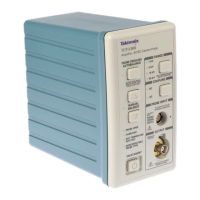TCP305 and TCP312 Performance Verification
Table 14: Equip
ment settings for rise time
Oscilloscope
Vertical inpu
t
impedance
50 Ω
Vertical sca
le
200 m A /di vis ion
Time base
2 ns/division
Record leng
th
500
Coupling DC
Offset 0 V (mid-sc
ale)
Trigger type Edge
Trigger mode Auto
Trigger p
osition
50%
Acquisi
tion mode
Average
Measurement type 32
Measurement type Rise Time
High am
plitude pulse generator
Amplitude Maximum
TCPA300
Coupling DC
Range
TCP305 5 A/V
TCP312 1 A/V
Procedure
1. Do not clamp the current probe around any conductor, but make sure the
jaws are locked shut.
2. Press the amplifier PROBE DEGAUSS AUTOBALANCE button. Wait for
the degauss/autobalance routine to complete before proceeding. The routine
is complete when the indicator light turns off.
3. Clamp the current probe around the HF current loop. Verify that the
arrow-shaped indicator on the probe points away from the pulse generator.
4. Adjust the vertical gain and vertical position of the oscilloscope so that 5 to
8 divisions are displayed. (You may have to adjust the pulse generator output
to achieve this.)
5. Using the measurement capability of the oscilloscope, measure the rise time
of the displayed pulse from 10% to 90% amplitude.
6. If the rise time of the pulse generator is greater than 1/4 of the rise time of the
probe you are testing, calculate the rise time of the probe (t
r
probe)usingthe
formula below:
TCPA300/400 Amplifiers and TCP300/400 Series Current Probes Service Manual 25

